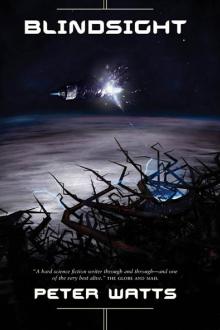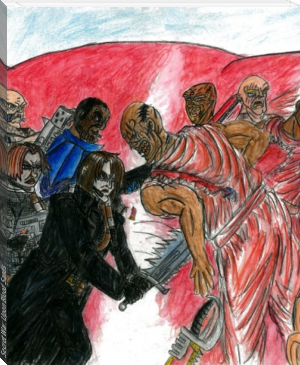Blindsight by Peter Watts (the unexpected everything TXT) 📖

- Author: Peter Watts
- Performer: 0765312182
Book online «Blindsight by Peter Watts (the unexpected everything TXT) 📖». Author Peter Watts
53 Oasa, Y. et al. 1999. A deep near-infrared survey of the chamaeleon i dark cloud core. Astrophysical Journal 526: 336-343.
54 Normile, D. 2001. Cosmic misfits elude star-formation theories. Science 291: 1680.
55 Lucas, P.W., and P.F. Roche. 2000. A population of very young brown dwarfs and free-floating planets in Orion. Monthly Notices of the Royal Astronomical Society 314: 858-864.
56 Najita, J.R., G.P. Tiede, and J.S. Carr. 2000. From stars to superplanets: The low-mass initial mass function in the young cluster IC 348. Astrophysical Journal 541(Oct. 1):977-1003.
57 Matthews, Jaymie. 2005. Personal communication.
58 Liu, W., and Schultz, D.R. 1999. Jovian x-ray aurora and energetic oxygen ion precipitation. Astrophysical Journal 526:538-543.
59 Chen, P.V. 2001. Magnetic field on Jupiter. The Physics Factbook, http://hypertextbook.com/facts/
60 Osorio, M.R.Z. et al. 2000. Discovery of Young, Isolated Planetary Mass Objects in the Orionis Star Cluster. Science 290: 103-106.
61 Lemley, B. 2002. Nuclear Planet. Discover23(8).
62 http://www.nuclearplanet.com/
63 Dulk, G.A., et al. 1997. Search for Cyclotron-maser Radio Emission from Extrasolar Planets. Abstracts of the 29th Annual Meeting of the Division for Planetary Sciences of the American Astronomical Society, July 28-August 1, 1997, Cambridge, Massachusetts.
64 Marley, M. et al. 1997. Model Visible and Near-infrared Spectra of Extrasolar Giant Planets. Abstracts of the 29th Annual Meeting of the Division for Planetary Sciences of the American Astronomical Society, July 28-August 1, 1997, Cambridge, Massachusetts.
65 Boss, A. 2001. Formation of Planetary-Mass Objects by Protostellar Collapse and Fragmentation. Astrophys. J. 551: L167.
66 Low, C., and D. Lynden-Bell. 1976. The minimum Jeans mass or when fragmentation must stop. Mon. Not. R. Astron. Soc. 176: 367.
67 Jayawardhana, R. 2004. Unraveling Brown Dwarf Origins. Science 303: 322-323
68 Fegley, B., and K. Lodders. 1996. Atmospheric Chemistry of the Brown Dwarf Gliese 229B: Thermochemical Equilibrium Predictions. Astrophys. J. 472: L37.
69 Lodders, K. 2004. Brown Dwarfs—Faint at Heart, Rich in Chemistry. Science 303: 323-324
70 Adam Burgasser. 2002. June 1 edition of the Astrophysics Journal Letters
71 Reid, I.N. 2002 Failed stars or overacheiving planets? Science 296: 2154-2155.
72 Gizis, J.E. 2001. Brown dwarfs (enhanced review) Online article supplementing Science 294: 801.
73 Clarke, S. 2003. Milky Way’s nearest neighbour revealed. NewScientist.com News Service, 04/11/03.
74 Basri, G. 2000. Observations of brown dwarfs. Annu. Rev. Astron. Astrophys 38:485-519.
75 Tamura, M. et al. 1998. Isolated and Companion Young Brown Dwarfs in the Taurus and Chamaeleon Molecular Clouds. Science 282: 1095-1097.
76 Berger, E. 2001. Discovery of radio emission from the brown dwarf LP944-20. Nature 410: 338-340.
77 Anonymous, 2000. A brown dwarf solar flare._ Science@Nasa_, http://science.nasa.gov/headlines/y2000/ast12jul_1m.htm
78 Schilling, G. 2001. Comet’s course hints at mystery planet. Science 292: 33.
79Evelyne Kohler, E. et al. 2002. Hearing Sounds, Understanding Actions: Action Representation in Mirror Neurons. Science 297: 846-848
80 Rizzolatti, G, and Arbib, M.A. 1998. Language Within Our Grasp. Trends in Neuroscience 21(5):188-194.
81 Hauser, M.D., N. Chomsky, and W.T. Fitch. 2002. The faculty of language: what is it, who has it, and how did it evolve? Science 298: 1569-1579.
82 Miller, G. 2005. Reflecting on Another’s Mind. Science 308: 945-947
83 Pfeiffer, T., S. Schuster, and S. Bonhoeffer. 2001. Cooperation and Competition in the Evolution of ATP-Producing Pathways Science 20 292: 504-507.
84 McMahon, R.J. 2003. Chemical Reactions Involving Quantum Tunneling. Science 299: 833-834.
85 Zuev, P.S. et al. 2003. Carbon Tunneling from a Single Quantum State. Science 299: 867-870
86 Darwin, Charlie “Chuckles”. 1859. The Origin of Species by Means of Natural Selection. Penguin Classics Edition, reprinted 1968. Originally published by John Murray, London.
87 Cho, A. 2004. Life’s Patterns: No Need to Spell It Out? Science 303: 782-783.
88 Cohen, J., and Stewart, S. 2005. Where are the dolphins? Nature 409: 1119-1122.
89Reilly, J.J. 1995. After Darwin. First Things, June/July. Article also available online at http://pages.prodigy.net/aesir/darwin.htm.
90 Devlin, K. 2004. Cracking the da Vinci Code. Discover 25(6): 64-69.
91 Snir, Y, and Kamien, R.D. 2005. Entropically Driven Helix Formation. Science 307: 1067.
92 Wolfram, S. 2002. A New Kind of Science. Wolfram Media. 1192pp.
93 Albert, M.L. 2004. Danger in Wonderland. Science 303: 1141
94 Muotri, A.R., et al. 2005. Somatic mosaicism in neuronal precursor cells mediated by L1 retrotransposition. Nature 435: 903-910.
95 Nelson, D.L., and M.M Cox. 200. Lehninger principles of biochemistry. Worth, NY, NY.
96 Prigonine, I., and G. Nicholis. 1989. Exploring Complexity. Freeman, NY.
97 Dawkins, R. 1988. The Blind Watchmaker: Why the Evidence of Evolution Reveals a Universe Without Design. Norton.
98 Pinker, S. 1997. How the mind works. WW Norton & Co., NY. 660pp.
99 Koch, C. 2004. The Quest for Consciousness: A Neurobiological Approach Roberts, Englewood, CO. 447pp.
100 McFadden, J. 2002. Synchronous firing and its influence on the brain’s electromagnetic field: evidence for an electromagnetic field theory of consciousness. J. Consciousness Studies, 9, No. 4, 2002, pp. 23-50
101 Penrose, R. 1989. The Emporer’s New Mind. Oxford University Press.
102 Tononi, G., and G.M. Edelman. 1998. Consciousness and Complexity. Science 282: 1846-1851.
103 Baars, B.J. 1988. A Cognitive Theory of Consciousness. Cambridge Univ. Press, New York.
104 Hilgetag, C.C. 2004. Learning from switched-off brains. Sci. Amer. 14: 8-9.
105 Roth, G. 2004. The quest to find consciousness. Sci. Amer. 14: 32-39.
106 Pauen, M. 2004. Does free will arise freely? Sci. Amer. 14: 41-47.
107 Zimmer, C. 2003. How the mind reads other minds. Science 300:1079-1080.
108 Crick, F.H.C., and C. Koch. 2000. The unconscious homunculus. In Neural Correlates of Consciousness—Empirical and Conceptual Questions (T. Metzinger, Ed.) MIT Press, Cambridge.
109 Churchland, P.S. 2002. Self-Representation in Nervous Systems. Science 296: 308-310.
110 Miller, G. 2005. What is the biological basis of consciousness? Science 309: 79.
111 Blakeslee, S. 2003. The christmas tree in your brain. Toronto Star, 21/12/03
112 Matsumoto, K., and K. Tanaka. 2004. Conflict and Cognitive Control. Science 303: 969-970.
113 Kerns, J.G., et al. 2004. Anterior Cingulate Conflict Monitoring and Adjustments in Control. Science 303: 1023-1026.
114 Petersen, S.E. et al. 1998. The effects of practice on the functional anatomy of task performance. Proceedings of the National Academy of Sciences 95: 853-860.
115 Nrretranders, T. 1999. The User Illusion: Cutting Consciousness Down to Size. Penguin Press Science. 467pp.
116 Altenmüller, E.O. 2004. Music in your head. Scientific American. 14: 24-31.
117 Helmuth, L. 2003. Fear and Trembling in the Amygdala. SCience 300: 568-569.
118 Dolan, R.J. 2002. Emotion, cognition, and behavior. Science 298: 1191-1194.
119 Treffert, D.A., and G.L. Wallace. 2004. Islands of genius. Scientific American 14: 14-23.
120 Wegner, D.M. 1994. Ironic processes of mental control. Psychol. Rev. 101: 34-52.
121 Proceedings of the Royal Society of London B (DOI 10.1098/rspb.2003.2548)
122 Aiello, L., and C. Dean. 1990. An introduction to human evolutionary anatomy. Academic Press, London.
123 Povinelli, D.J. 1993. Reconstructing the evolution of mind. Amer. Psychologist 48: 493-509.
124 Carstairs-McCarthy, A. 2004. Many perspectives, no concensus—a review of Language Evolution, by Christiansen & Kirby (Eds). Science 303:1299-1300.
125Dijksterhuis, A., et al. 2006. Science 311:1005-1007.
126Vince, G 2006. “‘Sleeping on it’ best for complex decisions.” Newscientist.com, http://www.newscientist.com/channel/being-human/dn8732.html.
127 Devlin, A.M., et al. 2003. Clinical outcomes of hemispherectomy for epilepsy in childhood and adolescence Brain 126: 556-566.
128 Pulsifer, M,B., et al. 2004. The cognitive outcome of hemispherectomy in 71 children. Epilepsia. 45: 243-54.
129 Moles, A., Keiffer, B.L., and F.R. D’Amato. 2004. Deficit in attachment behavior in mice lacking the -Opioid receptor gene. Science 304: 1983-1986.
130 Plane, J.M.C., et al. 2004. Removal of meteoric iron on polar mesospheric clouds. Science 304: 426-428.
131 Fitch, W.T., and M.D. Hauser. 2004. Computational Constraints on Syntactic Processing in a Nonhuman Primate. Science 303:377-380.
132 Premack, D. 2004. Is Language the Key to Human Intelligence? Science 303: 318-320
133 Holden, C. 2004. The origin of speech. Science 303: 1316-1319.
134 Graddol, D. 2004. The future of language. Science 303: 1329-1331.
135 BBC News. 2005. Brain chip reads man’s thoughts. March 31. Story online at http://news.bbc.co.uk/go/pr/fr/-/1/hi/health/4396387.stm
136 Weng, J. et al. 2001. Autonomous Mental Development by Robots and Animals. Science 291: 599-600.
137 Von Melchner, L, et al. 2000. Visual behaviour mediated by retinal projections directed to the auditory pathway. Nature 404: 871-876.
138 Baughman, R.H. 2003. Muscles made from metal. Science 300: 268-269.
139 Weissmüller, J., et al. 2003. Change-induced reversible strain in a metal. Science 300: 312-315.
140 Piper, A., and Merskey, H. 2004. The Persistence of Folly: A Critical Examination of Dissociative Identity Disorder. Part I. The Excesses of an Improbable Concept. Can. J. Psychiatry 49: 592-600.
141_ _Piper, A., and Merskey, H. 2004. The Persistence of Folly: A Critical Examination of Dissociative Identity Disorder. Part II. The Defence and Decline of Multiple Personality or Dissociative Identity Disorder. Can. J. Psychiatry 49: 678-683.
142 Kaplan, F.S., et al. 1998. The Molecules of Immobility: Searching for the Skeleton Key. Univ. Pennsylvania Orthopaedic J. 11: 59-66. Available online at http://www.uphs.upenn.edu/ortho/oj/1998/oj11sp98p59.html
143 Chernoff, H. 1973. Using faces to represent points in k-dimensional space graphically. Journal of the Americal Statistical Association 68:361-368.
144 Wilkinson, L. 1982. An experimental evaluation of multivariate graphical point representations. Human Factors in Computer Systems: Proceedings. Gaithersberg, MD, 202-209.





Comments (0)